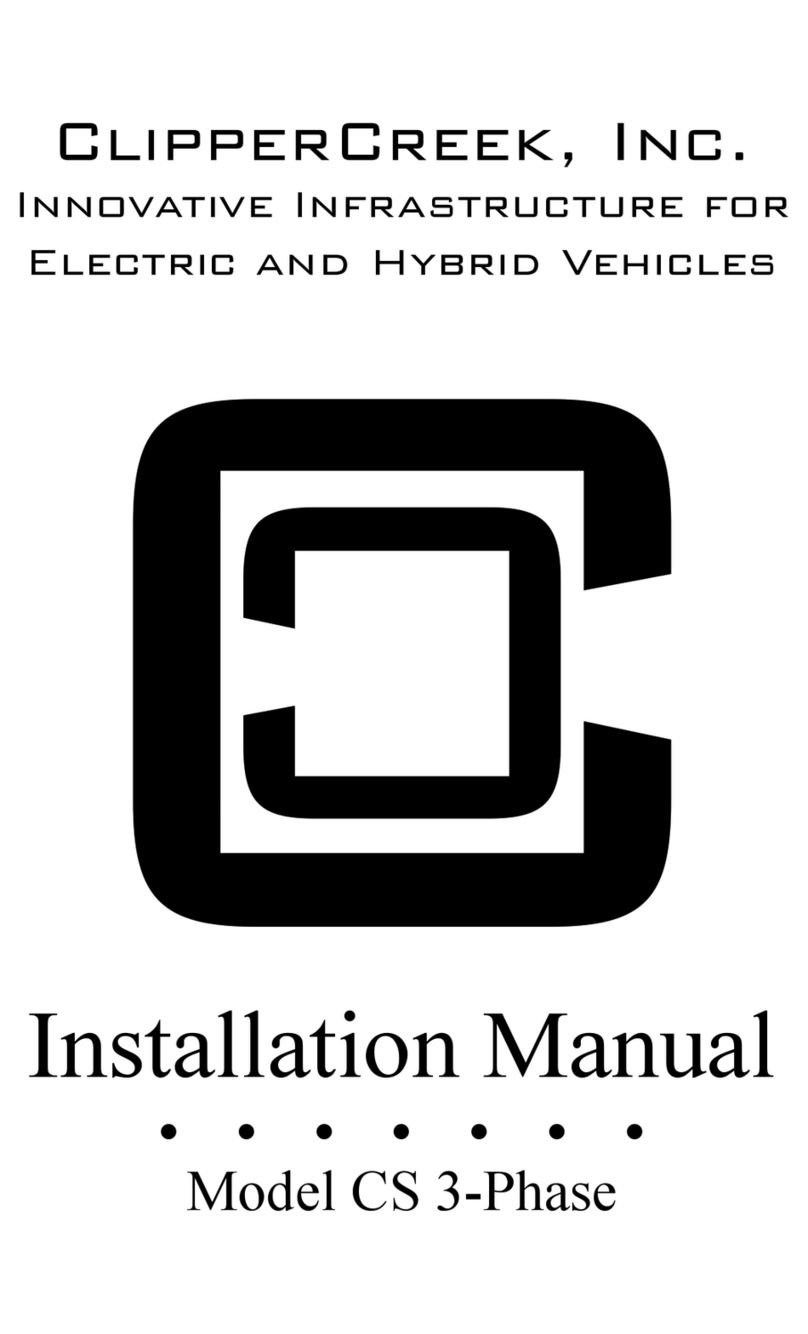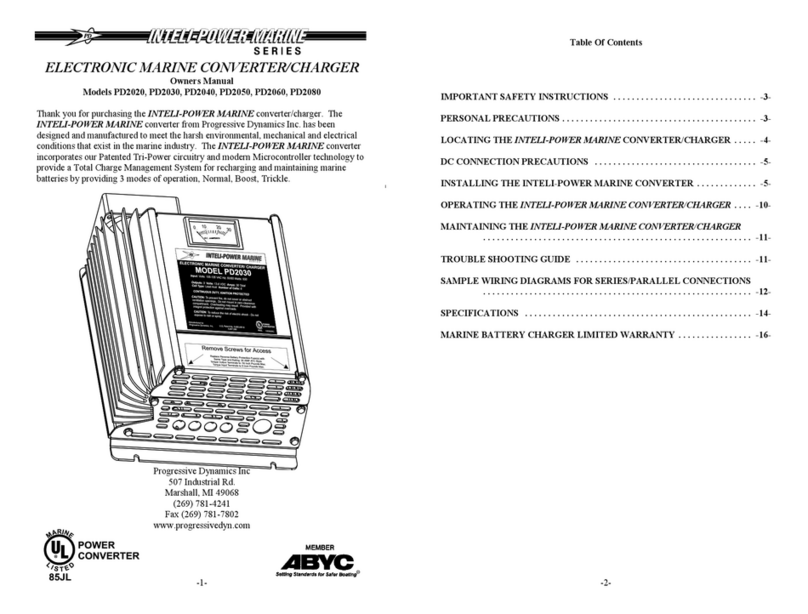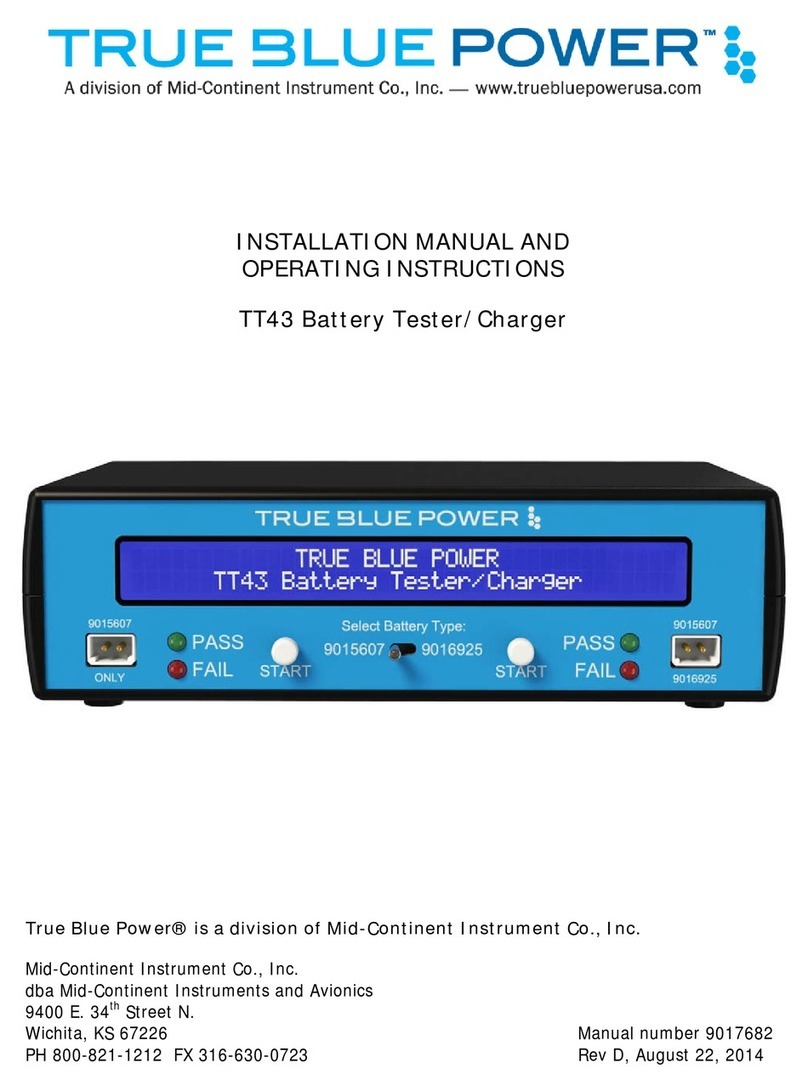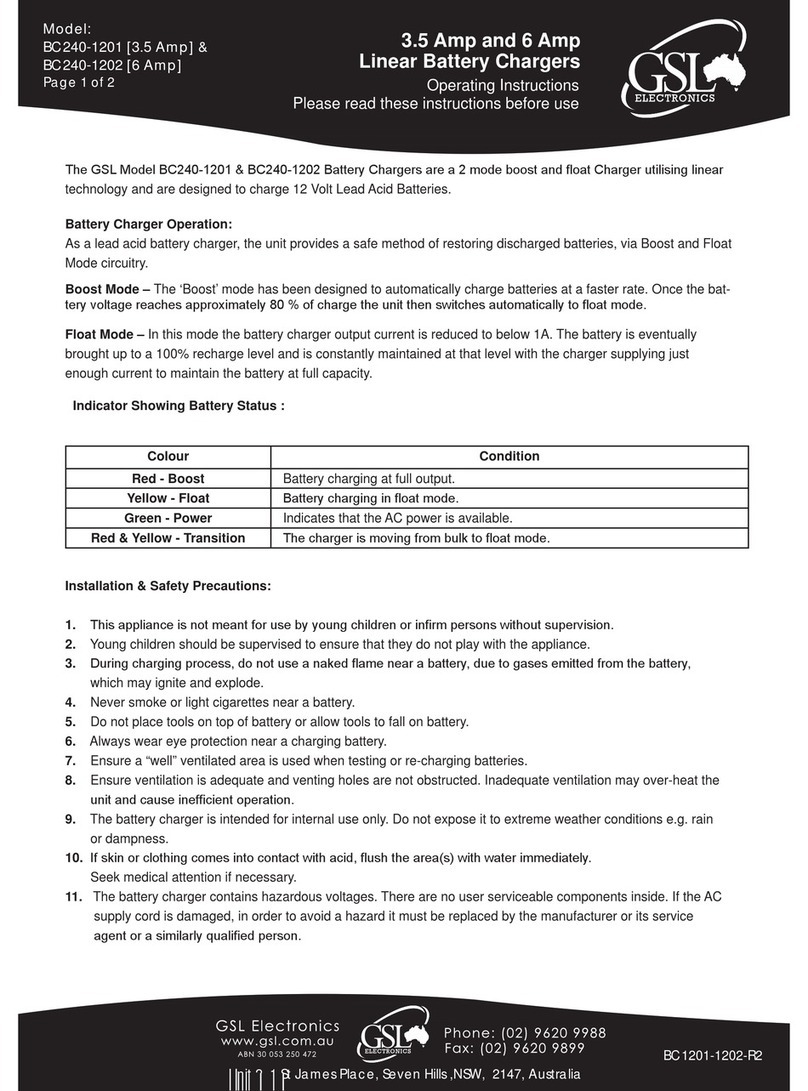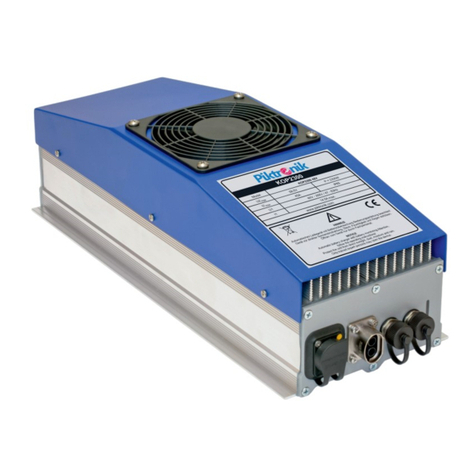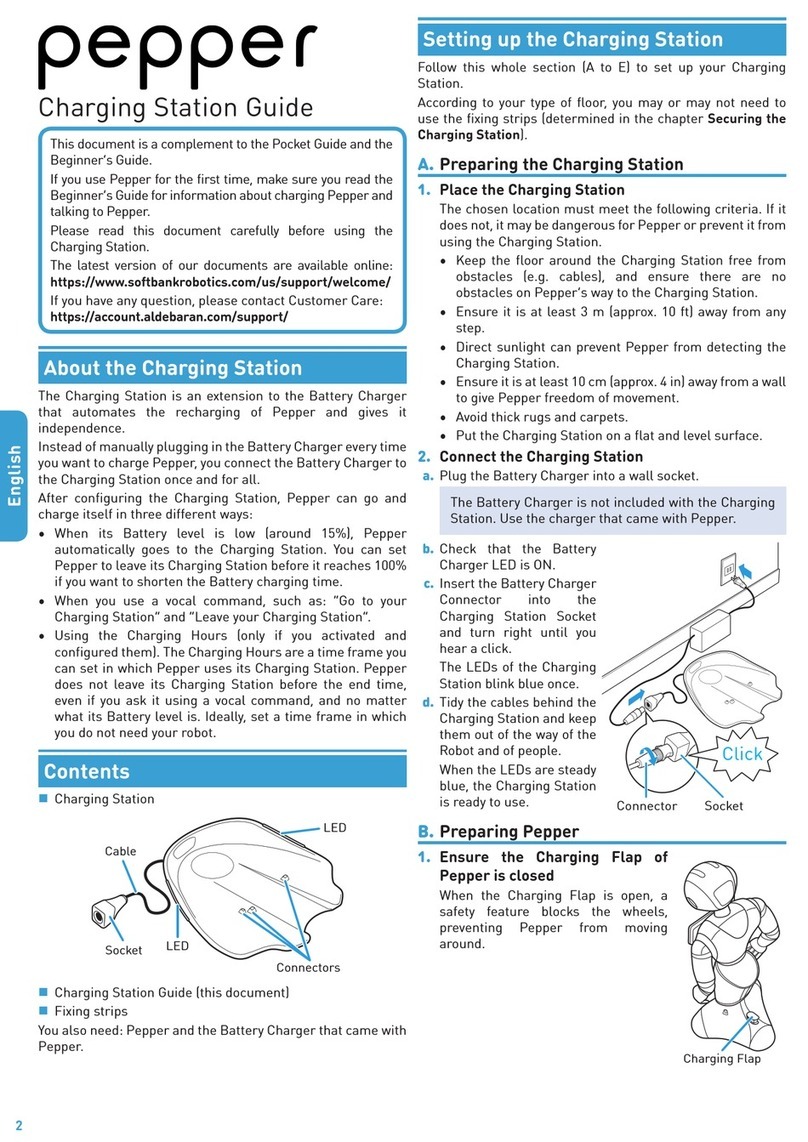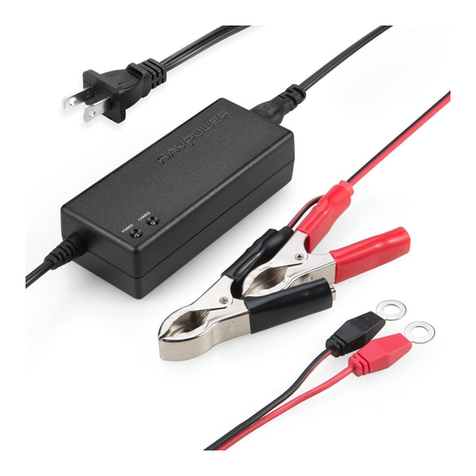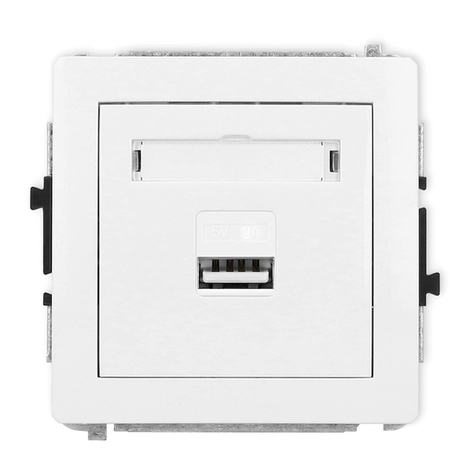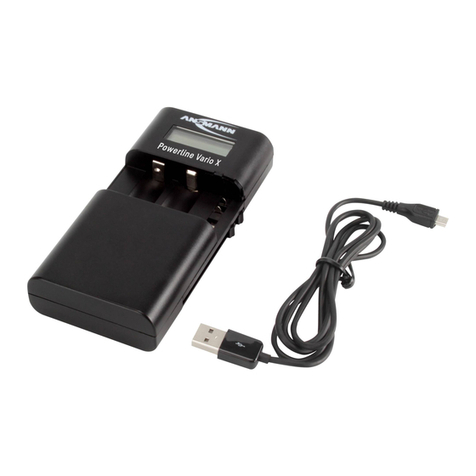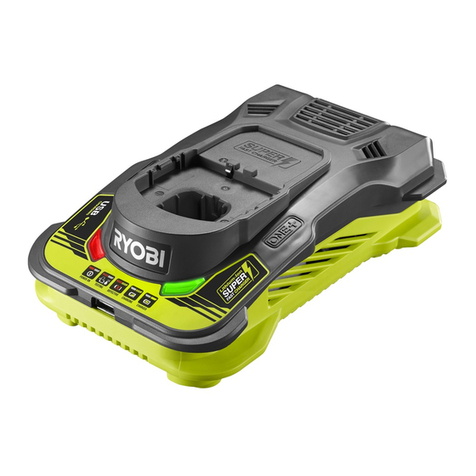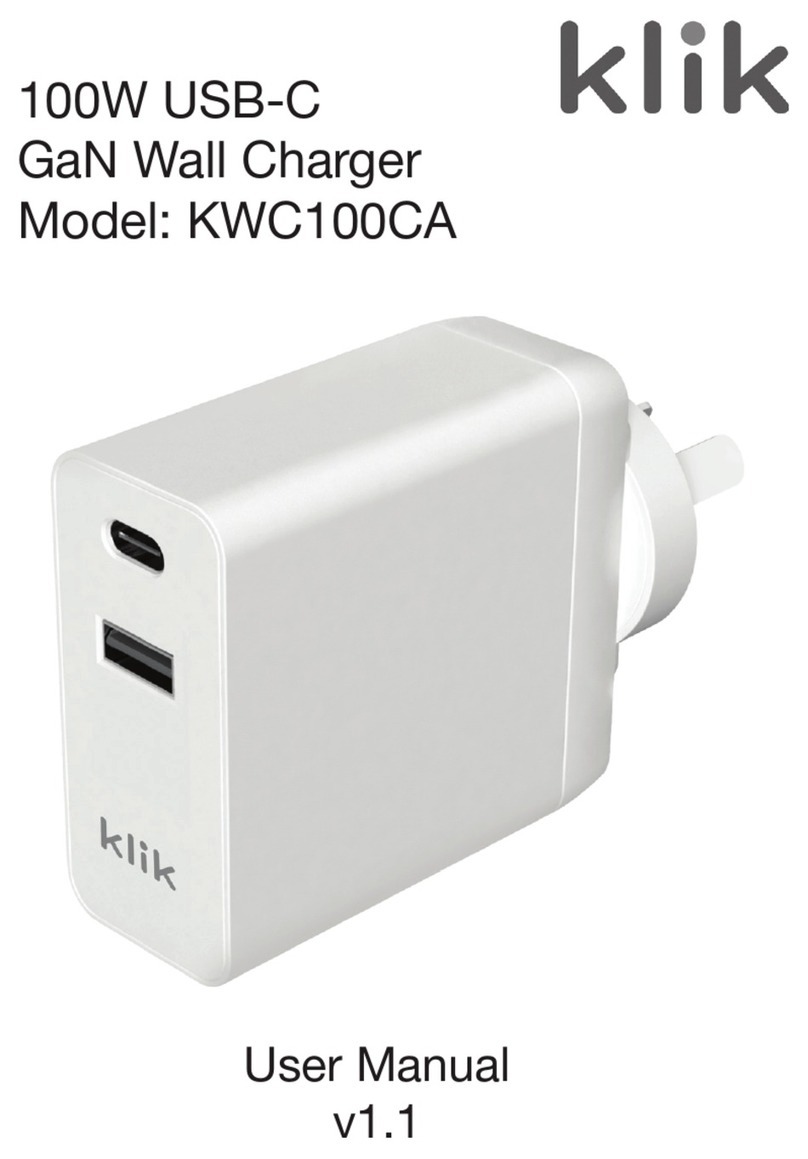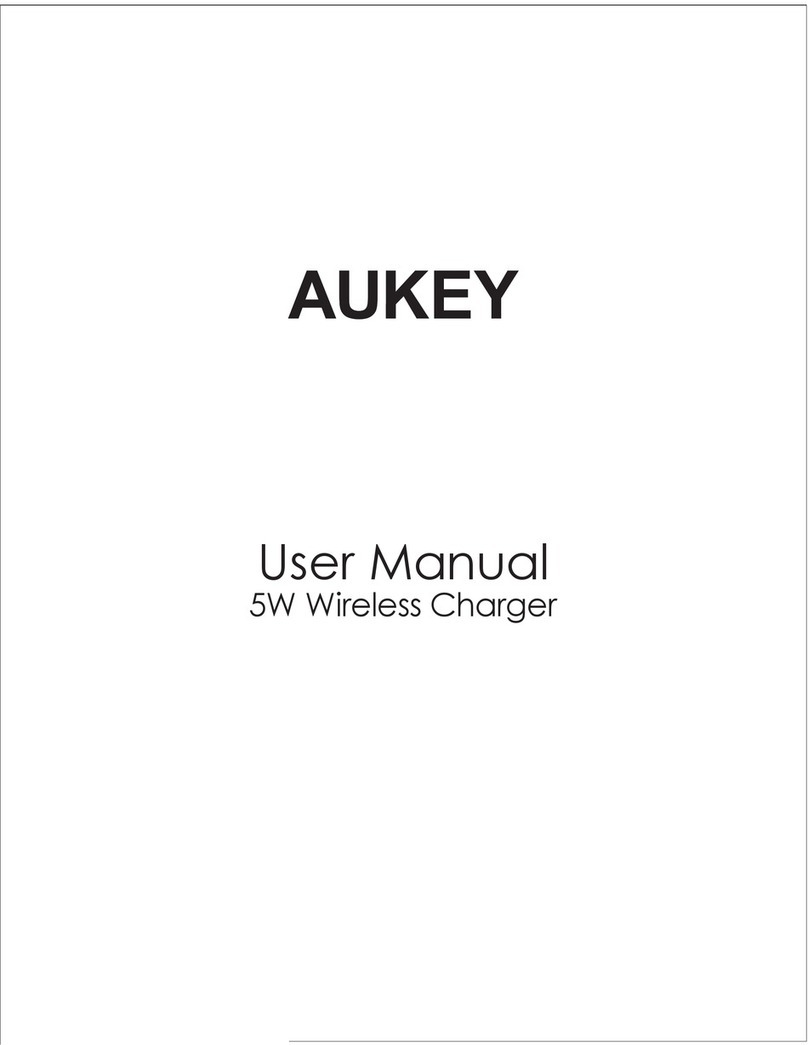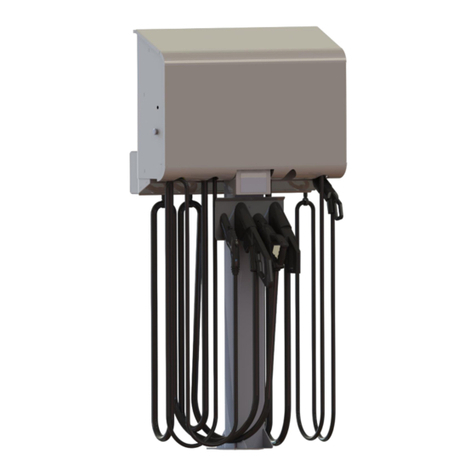ClipperCreek LCS Series User manual

ClipperCreek, Inc.
Innovative Infrastructure for
Electric and Hybrid Vehicles
• • • • • • •
Model LCS
User’s Manual

LCS User’s Manual
PLEASE NOTE
This user’s manual includes the latest information at the time of printing.
ClipperCreek, Inc. reserves the right to make changes to this product without further
notice. Changes or modications to this product by other than an authorized service
facility may void the product warranty.
If you have questions about the use of this product, contact your customer service
representative. Refer to the Customer Support section located in this guide.
LCS User’s Manual, Version 20, February 2019
Copyright © 2019. ClipperCreek, Inc.
All rights reserved. Printed in the USA.
Manual Number: 7004-0013-B
Please visit ClipperCreek’s Website @ www.clippercreek.com

LCS User’s Manual
CONTENTS
IMPORTANT SAFETY INSTRUCTIONS.................................... 5
ADDITIONAL SAFETY INFORMATION ................................... 7
FCC INFORMATION .................................................................... 8
OPERATION .................................................................................. 8
THE LCS FRONT PANEL............................................................. 9
INSTALLATION .......................................................................... 10
SERVICE CONNECTIONS ................................................... 10
MOUNTING PROCEDURES................................................ 14
MOUNTING THE CONNECTOR HOLSTER.................. 16
WIRING INSTRUCTIONS (Hardwired LCS)....................... 17
RECEPTACLE INSTRUCTIONS....................................... 18
CABLE WRAP GUIDELINES .............................................. 19
GROUNDING INSTRUCTIONS .......................................... 20
MOVING & STORAGE INSTRUCTIONS................................. 20
MAINTENANCE ...................................................................... 21
CUSTOMER SUPPORT ............................................................. 21
SPECIFICATIONS ....................................................................... 22
WARRANTY INFORMATION ................................................. 23

This page intentionally left blank.

LCS User’s Manual
Page 5
IMPORTANT SAFETY INSTRUCTIONS
Carefully read these instructions and the charging instructions in your vehicle
owner’s handbook before charging your electric vehicle.
The following symbols may be found in this manual or on labels afxed to the
charge station:
This means pay particular attention. Notes contain helpful suggestions.
Cela signie accorder une attention particulière. Les remarques
contiennent des suggestions utiles.
CAUTION: This symbol means be careful. You are capable of doing
something that might result in damage to the equipment.
ATTENTION: Ce symbole signie être prudent. Vous êtes capable de
faire quelque chose qui pourrait causer des dommages à l’équipement.
WARNING: This symbol means danger. You are in a situation
that could cause bodily injury. Before you work on any electrical
equipment, be aware of the hazards involved with electrical circuitry
and standard practices for preventing accidents.
AVERTISSEMENT: Ce symbole signie danger. Vous êtes dans
une situation qui pourrait causer des blessures corporelles. Avant de
travailler sur un équipement électrique, être conscient des dangers
présentés par les circuits électriques et les pratiques courantes de
prévention des accidents.
NOTE
Instructions Pertaining to a Risk of Fire or Electric Shock
When using the the LCS, basic electrical safety precautions should be followed:
• Use this charge station to charge electric vehicles equipped with an
SAE-J1772TM charge port only. Consult the vehicle owner’s manual to
determine if the vehicle is equipped with the correct charge port.
• Make certain the charge station SAE-J1772TM charge cable is positioned
so it will not be stepped on, tripped over, or otherwise subjected to
damage or stress.
• This product contains no user serviceable parts. Consult the Customer
Support section in this manual for service information. Do not attempt
to repair or service the charge station yourself.
• Do not operate your charge station if it or the SAE-J1772TM charge
cable is physically open, cracked, frayed, or otherwise visibly damaged.
Contact your Service Representative for service immediately. Consult
the Customer Support section in this manual for information on the
Service Representative in your area.

LCS User’s Manual
Page 6
• Not for use in commercial garages where a COMMERCIAL GARAGE
is dened as a facility (or portion thereof) used for the repair of
internal combustion vehicles in which the area may be classied due to
ammable vapors being present (such as from gasoline.)
• Do not place ngers inside of the coupler end of the SAE-J1772TM
charge cable.
• Do not allow children to operate this device. Adult supervision is
mandatory when children are in proximity to a charge station that is in
use.
Instructions se Rapportant à un Risque d’Incendie ou de Choc
Électrique
Lorsque l’utilisation de la LCS, précautions fondamentale de sécurité électrique
doivent être suivies:
• Utilisez cette station de recharge pour charger les véhicules électriques
équipés d’un SAE-J1772TM port de recharge seulement. Consultez le
manuel du propriétaire du véhicule an de déterminer si le véhicule est
équipé d’un correcte port de recharge.
• Assurez-vous que le SAE-J1772TM câble de recharge sur la station de
recharge est positionné de telle sorte qu’il ne sera pas piétiné, accroché
plus de, ou autrement endommagé ou de subir le stress.
• Ce produit ne contient aucune pièce réparable par l’utilisateur.
Consultez la section Support à la Clientèle dans ce manuel pour obtenir
des informations de service. N’essayez pas de réparer ou d’entretenir
la station de recharge vous-même.
• Ne faites pas fonctionner votre station ou le câble de recharge si elles
sont physiquement ouverte, ssuré, efloché, ou autrement visiblement
endommagé. Contactez votre représentant du service pour service
immédiatement. Consultez la section Support à la clientèle dans ce
manuel pour obtenir des informations sur le représentant du service
dans votre région.
• Ne pas utiliser dans les garages commerciaux où un garage commercial
est déni comme une installation (ou une partie) utilisé pour la
réparation de véhicules à combustion interne dans lequel la zone peut
être classée en raison de vapeurs inammables étant présents (Tels que
de l’essence.)
• Ne posez pas les doigts à l’intérieur de l’extrémité du SAE-J1772TM
coupleur du câble de recharge.
• Ne pas laisser les enfants utiliser cet appareil. Supervision d’un adulte
est obligatoire lorsque des enfants sont à proximité d’une station de
recharge qui est en cours d’utilisation.

LCS User’s Manual
Page 7
ADDITIONAL SAFETY INFORMATION
WARNING: Turn off input power to your charge station at the circuit
breaker panel before servicing or cleaning the unit.
AVERTISSEMENT: Couper l’alimentation d’entrée à votre station de
recharge sur le panneau de disjoncteur avant de nettoyer ou de réparer
l’appareil.
VENTILATION: Some electric vehicles require an external ventilation
system to prevent the accumulation of hazardous or explosive gases
when charging indoors. Consult the vehicle owner’s manual to
determine if your vehicle requires ventilation during indoor charging.
VENTILATION: Certains véhicules électriques nécessitent un système
de ventilation externe pour éviter l’accumulation de gaz explosifs
ou dangereux lors de la charge à l’intérieur. Consultez le manuel du
propriétaire du véhicule pour déterminer si votre véhicule nécessite une
ventilation quand le recharge en salle.
Vehicles which conform to the SAE-J1772TM standard for
communication can inform the charge station that they require an
exhaust fan. The LCS is not equipped to control ventilation fans. Do
not charge the vehicle with the LCS if ventilation is required.
Véhicules qui sont conformes à la norme SAE-J1772TM de
communication peuvent informer la station de recharge qu’ils
nécessitent un ventilateur d’extraction. Le LCS n’est pas équipé pour
contrôler les ventilateurs. Ne chargez pas le véhicule avec les LCS si la
ventilation est nécessaire.
CAUTION: DO NOT CHARGE a vehicle indoors if it requires
ventilation. Contact your Service Representative for information.
ATTENTION: NE PAS RECHARGER un véhicule à l’intérieur si il
nécessite une ventilation. Contactez votre représentant de service pour
plus d’informations.
Save these instructions for future reference.
Conservez ces instructions pour référence future.
NOTE
NOTE

LCS User’s Manual
Page 8
FCC INFORMATION
This device complies with Part 15 of the FCC rules. Operation is subject to the
following two conditions: (1) This device may not cause harmful interference,
and (2) This device must accept any interference received, including interference
that may cause undesired operation.
This product has been designed to protect against Radio Frequency Interference
(RFI). However, there are some instances where high powered radio signals or
nearby RF-producing equipment (such as digital phones, RF communications
equipment, etc.) could affect operation.
If interference to your charge station is suspected, we suggest the following
steps be taken before consulting your ClipperCreek Sales and Service
Representative for assistance:
1. Reorient or relocate nearby electrical appliances or equipment during
charging.
2. Turn off nearby electrical appliances or equipment during charging.
CAUTION: Changes or modications to this product by other than an
authorized service facility may void FCC compliance.
ATTENTION: Modications apportées à ce produit par quiconque
autre qu’un centre de service autorisé peut annuler la conformité FCC.
OPERATION
The LCS Electric Vehicle Charging Station is a compact wall-mounted charging
station that provides the Plug-in Hybrid or Battery Electric Vehicle (together
Plug-In Electric Vehicles, or “PEV”) user with a safe and manageable link be-
tween the power grid and the PEV. Both hardwired (LCS) and NEMA plug-
equipped (LCS-P) versions are available.
The LCS is very easy to use. Just unwrap the SAE-J1772TM charge cable and
plug the charge coupler rmly into the vehicle’s charge port.
Normally, the vehicle will immediately request a charge using a special commu-
nication line in the cable. Within a few seconds the green “Charging” light on
the face of the LCS will turn on and the charging cycle will begin. After an av-
erage driving day the vehicle battery pack will require several hours to recharge
completely. Charging overnight is the most convenient way to maintain healthy
batteries and ensure the vehicle’s full range will be available for the next day.
When the vehicle has stopped charging the green “Charging” light on the LCS
will turn off. To remove the charge coupler once a charge cycle has completed
(or to interrupt a charge in progress) press and hold down the latch release lever
on the charge coupler handle then unplug the charge coupler from the vehicle
charge port.

LCS User’s Manual
Page 9
Figure 1- Front Panel
THE LCS FRONT PANEL
The front panel on the LCS has four indicator lights:
POWER (yellow), indicates that power is available
to the LCS.
CHARGING (green), indicates that the vehicle
is requesting a charge and AC power is currently
applied to the vehicle.
POWER FAULT (red), indicates that the LCS is
not wired correctly. The problem can be due to
improper grounding or a missing Earth Ground.
The wiring should be examined by a qualied
electrician.
CHARGING FAULT (red), indicates that the LCS
is unable to communicate with the vehicle correctly,
or a safety fault condition has been detected by the
unit.
Table 1 - Front Panel LED Information

LCS User’s Manual
Page 10
INSTALLATION: SERVICE CONNECTIONS
CAUTION: To reduce the risk of re, connect only to a circuit provided
with the appropriate maximum branch circuit overcurrent protection in
accordance with the National Electrical Code, ANSI/NFPA 70 (US) or the
Canadian Electric Code C22.2 NO. 280-13 (Canada).
ATTENTION: Pour réduire le risque d’incendie, de se connecter
uniquement à un circuit fourni avec le approprié circuit de dérivation
protection maximale contre les surintensités, en conformité avec le Code
National électrique ANSI/NFPA 70 (US) ou Code Canadien de l’électricité
C22.2 NO. 280-13 (Canada).
CAUTION: This is a single-phase device. Do not connect all three
phases of a 3-phase feed !!! You may use any two phases of a three-
phase wye-transformer feed. The center-point of the three phases (usually
used as Neutral) must be grounded somewhere in the system. A Neutral
connection is not required by the LCS. Only Line 1, Line 2, and Ground
are required, as shown in Figure 3.
ATTENTION: Il s’agit d’un appareil monophasé. Ne pas relier tous
les trois phases d’une alimentation triphasée!!! Vous pouvez utiliser
les deux phases d’un triphasé en étoile transformateur alimentation. Le
point central des triphasé (généralement utilisé comme Neutre) doit être
mis à la terre quelque part dans le système. Une connexion Neutre n’est
pas exigée par la LCS. Seulement ligne 1, ligne 2, et Mise à la Terre sont
nécessaires, comme le montre la Figure 3.
CAUTION: The two phases used must each measure 120V to Neutral.
Earth Ground must be connected to Neutral at only one point, usually at
the service entry breaker panel.
ATTENTION: Les deux phases utilisées doivent mesurer chaque 120V
à Neutre. Mise à la terre doit être connecté au Neutre en un seul point,
généralement à l’entrée panneau de disjoncteurs de service.
Service Connections Table, Page 6
LCS Model Circuit Breaker Rating Receptacle Type
LCS Modèle Calibre de Disjoncteur Prise Électrique
LCS-10 (Hardwired) 10A n/a
LCS-15 (Hardwired) 15A n/a
LCS-20 (Hardwired) 20A n/a
LCS-20P + NEMA L6-30P 30A NEMA L6-30R
LCS-20P + NEMA 14-30P 30A NEMA 14-30R
LCS-20P + NEMA 6-50R 50A NEMA 6-50R
LCS-20P + NEMA 14-50P 50A NEMA 14-50R
LCS-25 (Hardwired) 25A n/a
LCS-25P + NEMA L6-30P 30A NEMA L6-30R
LCS-25P + NEMA 14-30P 30A NEMA 14-30R
LCS-25P + NEMA 6-50P 50A NEMA 6-50R
LCS-25P + NEMA 14-50P 50A NEMA 14-50R
LCS-30 (Hardwired) 30A n/a
LCS-30P + NEMA L6-30P 30A NEMA L6-30R
LCS-30P + NEMA 14-30P 30A NEMA 14-30R
LCS-30P + NEMA 6-50P 50A NEMA 6-50R
LCS-30P + NEMA 14-50P 50A NEMA 14-50R

LCS User’s Manual
Page 11
CAUTION: If a 240V 3-phase feed is from a Delta-connected
secondary, the leg used must have a center-tap. That tap must be
Grounded. Only the two phases either side of the center-tapped leg can
be used. See Figure 4 below.
ATTENTION: Si une alimentation à triphasé 240V provient d’un
triangle connecté secondaire, la bornes utilisée doit avoir un centre-
tap. Que la tap doit être Mise à la Terre. Seuls les deux phases l’une ou
l’autre côté du centre tapped brancher peut être utilisé. Voir la Figure 4
ci-dessous.
CAUTION: Warranty is void if this unit is not wired properly
ATTENTION: La garantie est annulée si cette unité n’est pas
correctement câblé
WARNING: Only a qualied electrician should perform the
installation. The installation must be performed in accordance with all
local electrical codes and ordinances.
AVERTISSEMENT: Seul un électricien qualié doit effectuer
l’installation. L’installation doit être effectuée conformément à tous les
codes électriques locaux et des ordonnances.
Only 3 wires are connected, but care must be taken that the service transformer
secondary connection is denitely known, and the 3 wires from the main circuit
breaker panel are connected and labeled correctly. Figures 2, 3, and 4 below
show the most common service transformer secondary wiring formats.
Notice that L1, L2, & Ground are labeled on each diagram. Those transformer
outputs correspond to the same inputs on the LCS. Also, each of the two
3-phase diagrams shows an L3 output, which is not used. Do not connect all
three phases of a 3-phase secondary to the LCS. This is a single-phase device.
The Neutral at the service panel must be connected to Earth Ground somewhere
in the system on any of the three connection arrangements. Ground-fault
protection is not possible unless the Neutral (center-tap on the service
transformer) is connected to an Earth Ground. If no Ground is provided by
the electrical service, a grounding stake must be driven into the ground nearby,
following local electrical codes. The grounding stake must be connected to the
ground bar in the main breaker panel, and Neutral connected to Ground at that
point.
WARNING: Local electrical codes must always be followed when
installing the grounding stake.
AVERTISSEMENT: Les codes électriques locaux doivent toujours
être respectées lors de l’installation du piquet de mise à la terre.

LCS User’s Manual
Page 12
Figure 3 - 208V 3-Phase, Wye-Connected
The following diagrams illustrate the three service transformer secondary
connections most common in North America.
With a wye-connected secondary, any two of the legs can be used to
provide 208V to the LCS. For example, L1 & L2, or L1 & L3, or L2
& L3. Leave the unused leg open. Do not connect it to a Neutral bar, or
to Ground. Be sure the center point is Earth Ground somewhere in the
system.
Avec un transformateur étoile-connecté secondaire, deux des lignes
peut être utilisé pour fournir 208V à la LCS. Par exemple , L1 & L2,
ou L1 & L3, ou L2 & L3. Laissez la borne inutilisée ouverte. Ne le
connectez pas à un bar Neutre, ou à la Mise à la Terre. Assurez-vous
que le point central est Mis à la Terre quelque part dans le système.
NOTE
Figure 2 - 220/240V Single Phase
120V
120V
240V
NEUTRAL
(NOT USED)
L1
L2
GROUND
120V
120V
208V
NEUTRAL
(NOT USED)
L1
L2
GROUND
L3 (NOT USED)

LCS User’s Manual
Page 13
CAUTION: With the delta connection, one leg must be center-tapped.
Only the two phases on either side of the center tap can be used. The
two phases must both measure 120V to Neutral. The third line (L3)
of the delta is 208V, with respect to Neutral, and is sometimes referred
to as a “stinger”. Do not use this third line! Consult the transformer
manufacturer’s literature to be sure the single leg can supply the
required power.
ATTENTION: Avec la connexion triangle, une borne doit être centre-
tapped, et seulement les deux phases d’un côté ou de l’autre du centre
tap peut être utilisé. Les deux phases doivent mesurer 120V à Neutre.
Ta troisième ligne (L3) du delta est 208V, par rapport à la position
Neutre, et il est parfois désigné comme un “stinger”. Ne pas utiliser
ce troisième ligne! Consultez la documentation du transformateur
fabricant pour être sûr du borne unique peut fournir la puissance
requise.
Figure 4 - 240V 3-Phase, Delta-Connected, with center-tap on one leg
120V
120V
240V
NEUTRAL
(NOT USED)
L1
L2
GROUND
L3 (DO NOT USE!)

LCS User’s Manual
Page 14
MOUNTING PROCEDURES
Locate the wall mounting position of the EVSE:
• On the hardwired LCS, the three service conductors are shielded by three
feet of exible conduit. The LCS must be positioned such that this conduit
can reach a nearby service panel or junction box.
• On the plug-in LCS-P, the NEMA plug head is connected by nearly one foot
of cable to the top side of the LCS-P. The LCS-P must be positioned such
that this plug can safely be inserted into a wall-mounted NEMA socket.
• Position the bottom of the charge station at a comfortable height and at least
18 inches above the ground. Ensure that the LEDs on the front panel of the
EVSE can clearly be seen by anyone who will be operating the device.
• The LCS has four mounting holes spaced in a 2” wide by 10” tall
rectangular pattern. Use a template to mark hole locations on the wall.
WARNING: For safety, always turn off input power to the charge
station at the circuit breaker panel prior to plugging it in or wiring
it to the service lines. Likewise, turn off the circuit breaker prior to
unplugging it or disconnecting the unit from the service lines.
AVERTISSEMENT: Pour sécurité, toujours désactiver le courant
d’entrée de la station de recharge au niveau du disjoncteur du panneau
avant de le brancher ou de câblage à les lignes de service. De même,
coupez le disjoncteur avant de le débrancher ou déconnecter l’unité à
partir des lignes de services.
CAUTION: A 3-phase delta-connected transformer secondary without
a center-tap on one leg cannot be used with the LCS. No “Neutral”
point is available to be connected to ground for ground-fault protection.
The LCS will not allow the contactor to close if it does not sense the
presence of a Ground wire connected to a “Neutral” point on the
transformer secondary.
ATTENTION: Un triphasé triangle-connecté transformateur
secondaire sans centre-tap sur le terminal ne peut pas être utilisé avec la
LCS. Aucun point “Neutre” est disponible pour être connecté à Mise à
la Terre pour protection de défaut à la terre. Le LCS ne permettra pas le
contacteur de fermer si elle ne détecte pas la présence d’un l de Masse
connecté à un point “Neutre” sur le secondaire du transformateur.

LCS User’s Manual
Page 15
For Solid-Wall Construction:
• To secure the unit in concrete, pre-drill appropriately sized holes and use
multi-set or wedge anchor hardware at all four mounting points.
• To secure the unit in brick or stone, pre-drill appropriately sized holes and
use multi-set or wedge anchor hardware at all four mounting points.
Machine screw size #10 hardware is recommended for mounting the LCS.
Screw shafts of at least 2” are recommended. The LCS mounting holes are
3/16” in diameter, so ensure that the screw heads do not exceed this size. Place
appropriately sized washers between the screw heads and the LCS enclosure
mounting anges.
Figure 5 - Mounting the LCS to a hollow wall
For Hollow-Wall Construction:
• Place the unit such that at least two (but preferably all four) mounting holes
can take advantage of solid structural framing inside of the wall or a strong
wall surface such as plywood.
• For any remaining mounting holes which do not have a solid mounting
structure (such as drywall without a solid backing) it will be necessary to
use proper anchoring hardware such as drywall toggles or molly bolts.

LCS User’s Manual
Page 16
MOUNTING THE SAE-J1772™
CONNECTOR HOLSTER
The SAE-J1772™ connector holster comes standard to provide a convenient,
protective housing for the SAE-J1772™ connector head when it is not in use.
• The SAE-J1772™ connector holster should be placed so that users have
easy and safe access to the SAE-J1772™ connector.
• For indoor installation, mount the SAE-J1772™ connector holster between
18 and 48 inches above the ground or grade.
• For outdoor installation, mount the SAE-J1772™ connector holster between
24 and 48 inches above the ground or grade.
• The SAE-J1772™ connector holster has two vertically aligned mounting
holes spaced 5.45” apart, one each on the enclosure top and bottom. Use a
ruler or template to mark hole locations on the mounting surface.
• The vertical alignment of the LCS and SAE-J1772™ connector holster
mounting holes allows for the convenient mounting of both components
onto the same post or wall structure. For example, the holster may be
mounted directly above the LCS.
• Place the SAE-J1772™ connector holster such that both mounting holes can
take advantage of solid structural framing inside of the wall or a strong wall
surface such as plywood.
• A set of exterior wood screws and stainless steel washers are included for
the purposes of mounting the SAE-J1772™ connector holster to a wooden
surface.
• For mounting to a solid surface such as concrete, brick, or stone, alternate
hardware may need to be procured. Examples of solid-wall mounting
hardware include multi-sets, wedge anchors and sleeve anchors. Use the
type of mounting hardware most appropriate for the supporting structure.
Figure 6 - Mounting the holster using the exterior wood screws and washers

LCS User’s Manual
Page 17
WIRING INSTRUCTIONS (Hardwired LCS)
Route the LCS conduit to a nearby service panel or junction box. Use the
included ¼” trade size watertight tting to provide a moisture-resistant seal with
the service panel or junction box. If necessary, drill a 1/2” diameter hole to
accommodate the liquid-tight tting or use the included 1/4” NPT to 1/2” NPT
thread reducer kit.
Figure 7 - Wiring the LCS in a junction box
The three LCS service conductors use
stranded 12AWG, 75ºC copper wire. The
insulation of each conductor is color coded
for standard 240VAC installation:
Green: Ground
Black: Line 1 (120VAC to Ground)
Red: Line 2 (120VAC to Ground)
Les trois conducteurs service la LCS utiliser
multibrins 12 AWG, 75ºC l de cuivre.
L’isolation de chaque conducteur est un code
couleur pour une installation standard de 240
V CA:
Vert: Mise à la Terre
Noir: Ligne 1 (120VAC à Mise à la Terre)
Rouge: Ligne 2 (120VAC à Mise à la Terre)
NOTE
NOTE Before connecting the LCS service
conductors, please carefully read the section
of this manual titled Service Connections
on page 10. If you are unsure of the type of
power provided at the service panel, please
consult with your local utility or call your
Service Representative for assistance.

LCS User’s Manual
Page 18
RECEPTACLE INSTRUCTIONS (Plug-In LCS-P)
The LCS-P is tted with one of the following NEMA plugs:
NEMA L6-30P
NEMA 14-30P
NEMA 6-50P
NEMA 14-50P
The plug extends from the top of the LCS enclosure. Regulations limit this
plug to a maximum of 12 inches in length. For this reason, the LCS-P must be
mounted below the NEMA receptacle and must also be located within 12 inches
of it.
The NEMA 14-50P, 14-30P, and 6-50P congurations, the ground pin is located
at the top position of the plug. With this in mind, it is recommended that a
NEMA 14-50R, 14-30R, or 6-50R receptacle be oriented accordingly, such that
the ground socket is at the highest point.
Figure 8 - Preferred orientation of the NEMA receptacles above the LCS-P
NEMA 14-30 plug shown in gure

LCS User’s Manual
Page 19
CHARGE CABLE WRAP GUIDELINES
The LCS enclosure body is sculpted to allow the charge cable to be wrapped
around it for convenient storage as well as to keep the bulk of the cable off of
the ground and out of the way. As the charge cable is comprised of a number of
wires, coiling the charge cable too tightly around the LCS enclosure will result
in the charge cable feeling warmer to the touch than would ordinarily be the
case.
To minimize this effect, it is recommended that the charge cable be loosely
draped around the LCS enclosure body with larger loops. This will also permit
greater convenience in “pulling off” additional loops if a longer charge cable
reach is desired.
Figure 10. Drape the charge cable loosely around the LCS enclosure

LCS User’s Manual
Page 20
MOVING & STORAGE INSTRUCTIONS
Note that both the hardwired LCS and the plug-in LCS-P are intended for xed
installations. For mounting requirements, consult the Mounting Procedures
section of the Installation Instructions in this manual.
Aways turn off input power to the charge station at the circuit breaker panel
prior to hard-wiring an LCS to or disconnecting an LCS from the service lines.
Likewise, always turn off input power to the charge station at the circuit breaker
panel prior to plugging an LCS-P into or unplugging an LCS-P from a NEMA
socket.
When transporting the charge station, do not lift or carry the entire unit by the
SAE-J1772TM charge cord. Likewise, do not lift or carry the entire unit by the
exible conduit and input conductors (LCS) or the NEMA plug (LCS-P).
The charge station has a non-operational storage temperature range of -40°C to
+80°C (-40°F to +176°F).
GROUNDING INSTRUCTIONS
This product must be grounded. If this product should malfunction or break
down, grounding provides a path of least resistance for electric current to reduce
the risk of electric shock.
For the hardwired LCS:
The hardwired LCS is equipped with three service conductors shielded by three
feet of exible conduit. This product must be connected to a grounded, metal,
permanent wiring system, or an equipment-grounding conductor must be run
with the circuit conductors and connected to the ground lead on the product.
For the plug-in LCS-P:
The plug-in LCS-P is equipped with a cord having an equipment grounding
conductor and a grounding plug. The plug must be plugged into an appropriate
outlet that is properly installed and grounded in accordance with all local codes
and ordinances.
WARNING: Improper connection of the equipment-grounding
conductor may result in a risk of electric shock. Check with a qualied
electrician if doubt exists as to whether the product is properly
grounded. Do not modify the plug provided with the product – if it will
not t the outlet, have a proper outlet installed by a qualied electrician.
AVERTISSEMENT: Une mauvaise connexion du conducteur de terre
peut entraîner un risque de choc électrique. Vérier avec un électricien
qualié si il existe un doute quant à savoir si le produit est correctement
mis à la terre. Ne pas modier la che fournie avec le produit – si elle
n’entre pas dans la prise, faites installer une prise adéquate par un
électricien qualié.
Other manuals for LCS Series
1
This manual suits for next models
8
Table of contents
Other ClipperCreek Batteries Charger manuals
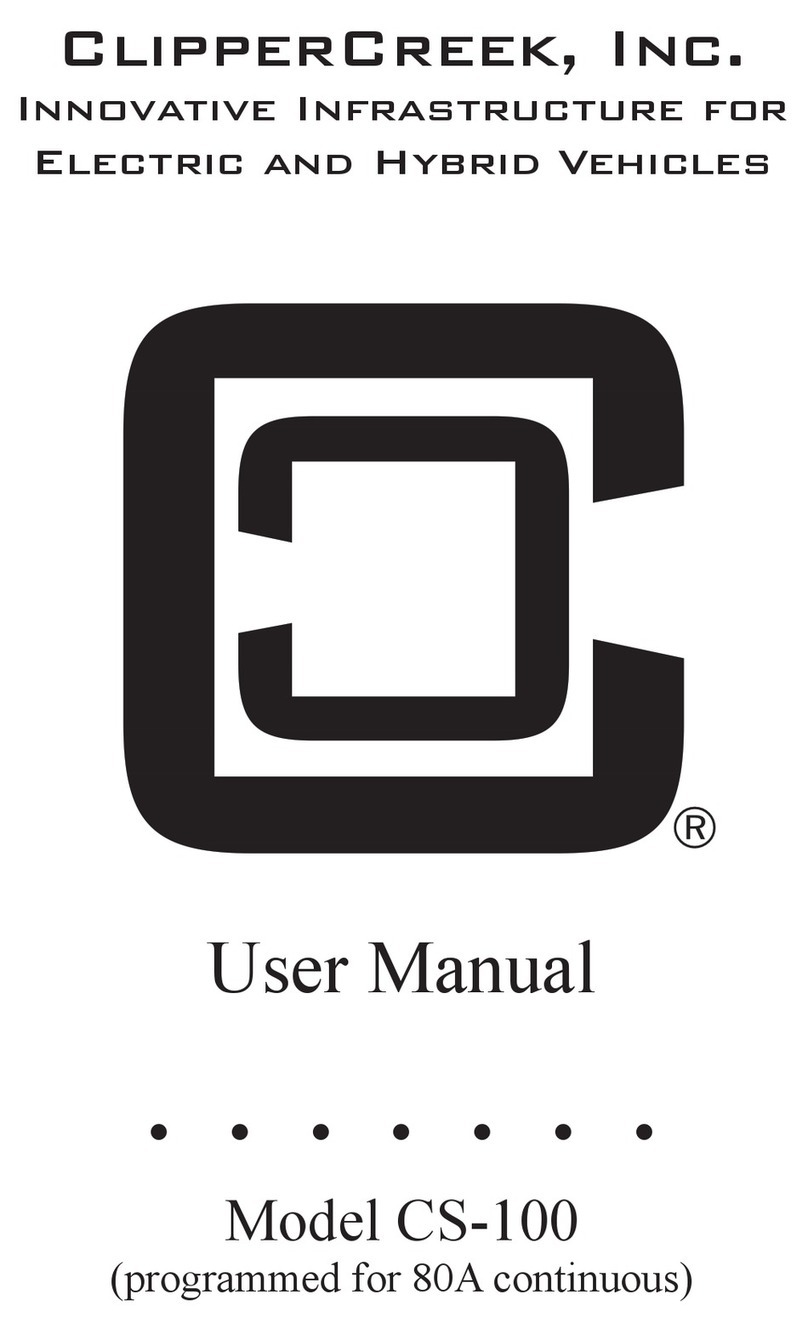
ClipperCreek
ClipperCreek CS-100 User manual
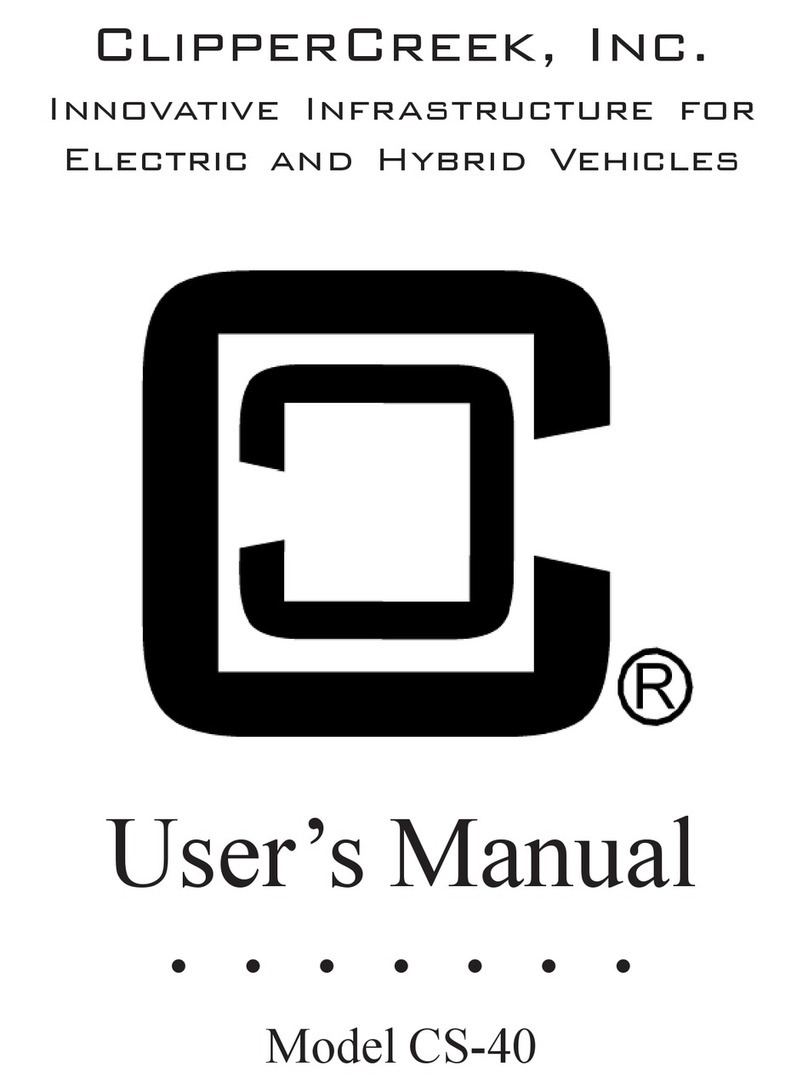
ClipperCreek
ClipperCreek CS-40 User manual

ClipperCreek
ClipperCreek HCS User manual

ClipperCreek
ClipperCreek EV Series User manual
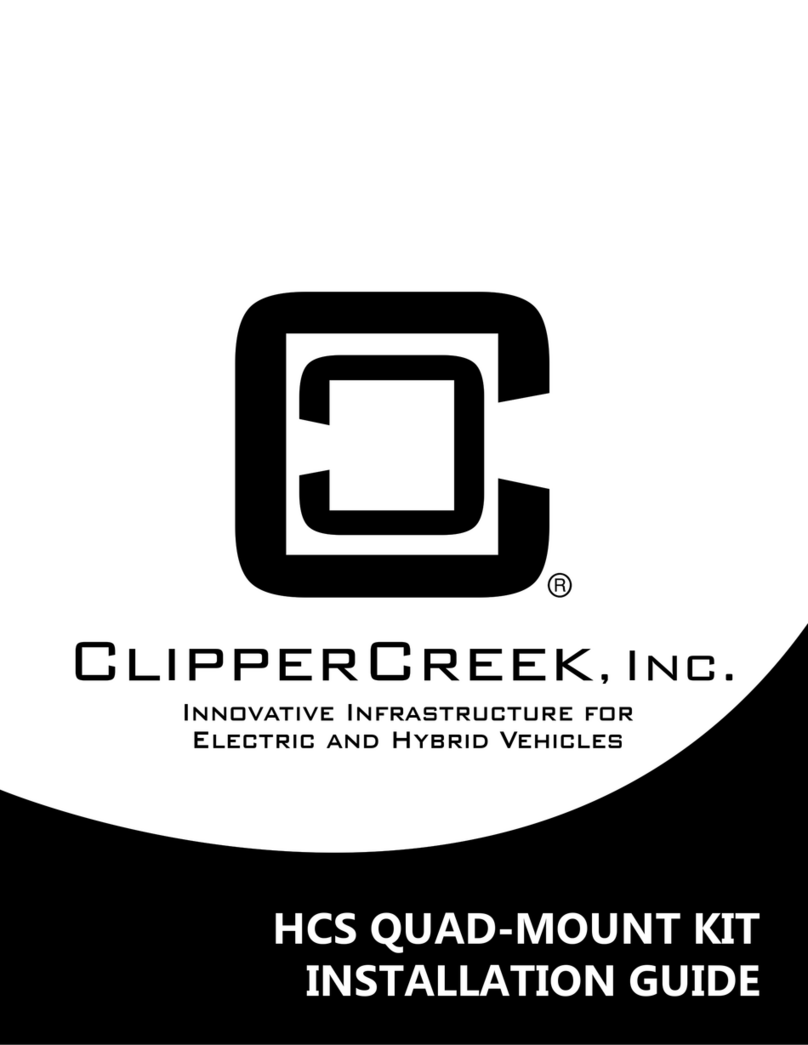
ClipperCreek
ClipperCreek HCS SERIES User manual
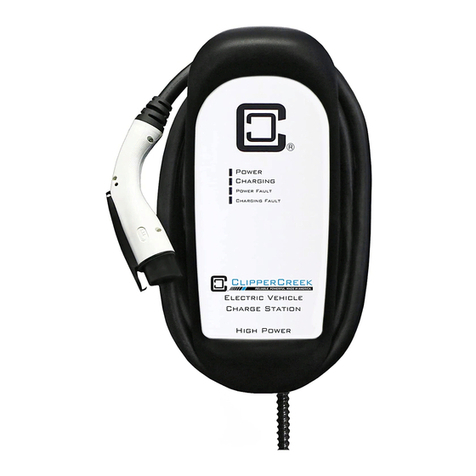
ClipperCreek
ClipperCreek HCS SERIES User manual
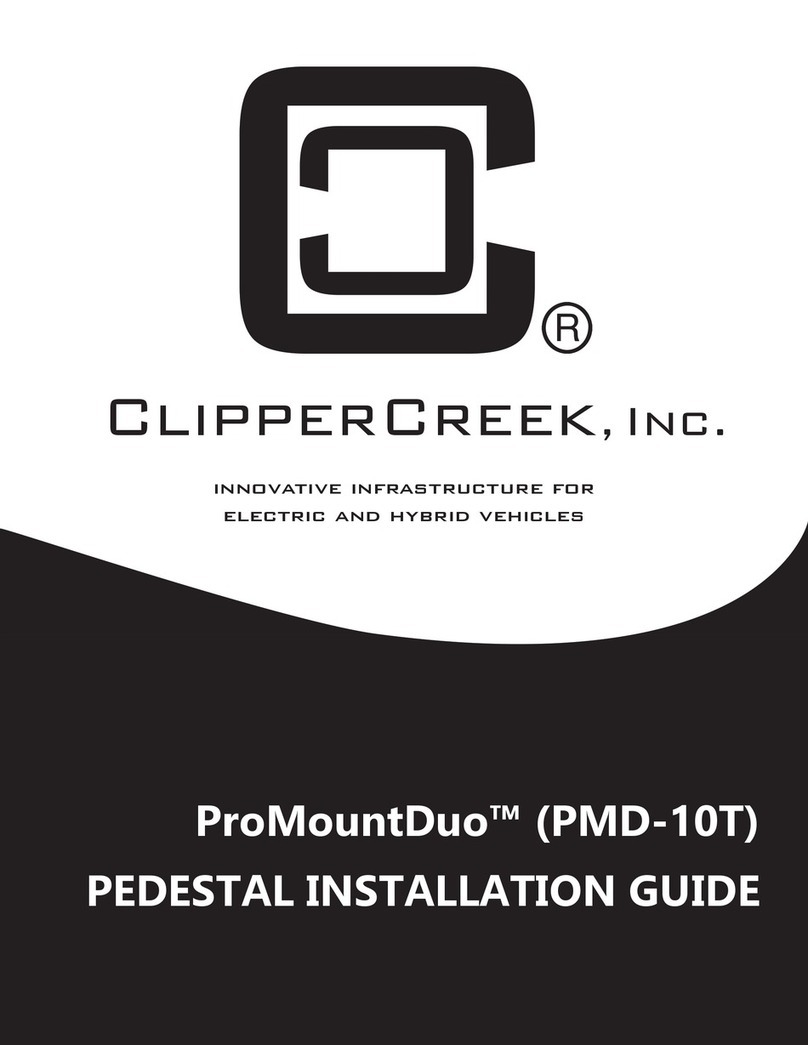
ClipperCreek
ClipperCreek ProMountDuo PMD-10T User manual
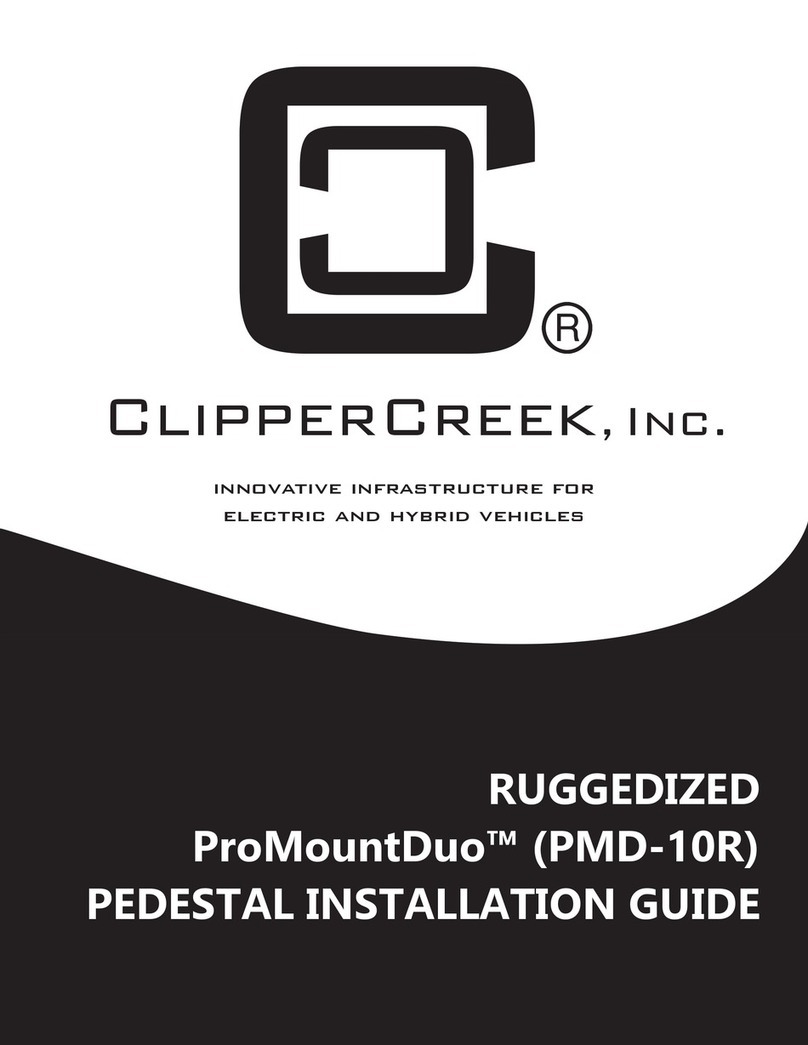
ClipperCreek
ClipperCreek ProMountDuo PMD-10R User manual
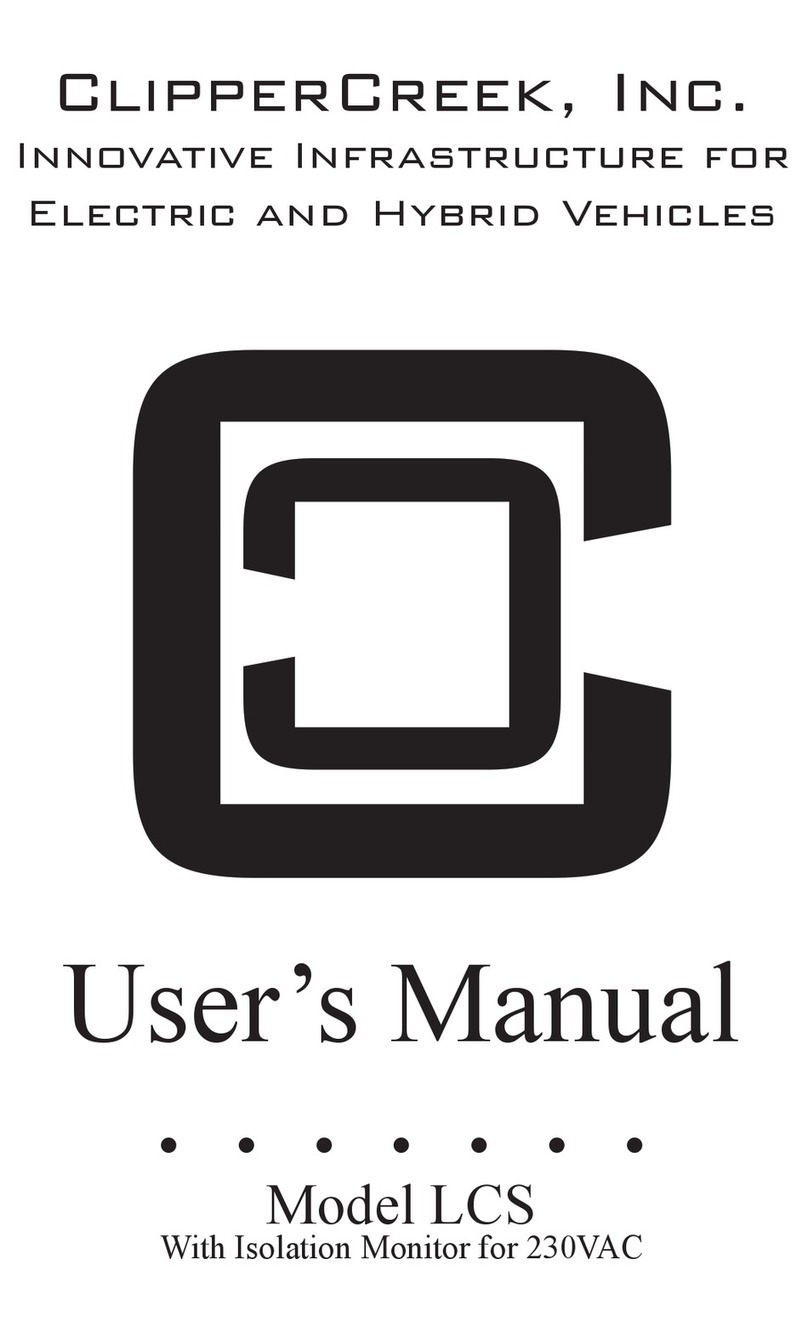
ClipperCreek
ClipperCreek LCS Series User manual

ClipperCreek
ClipperCreek HCS SERIES User manual
